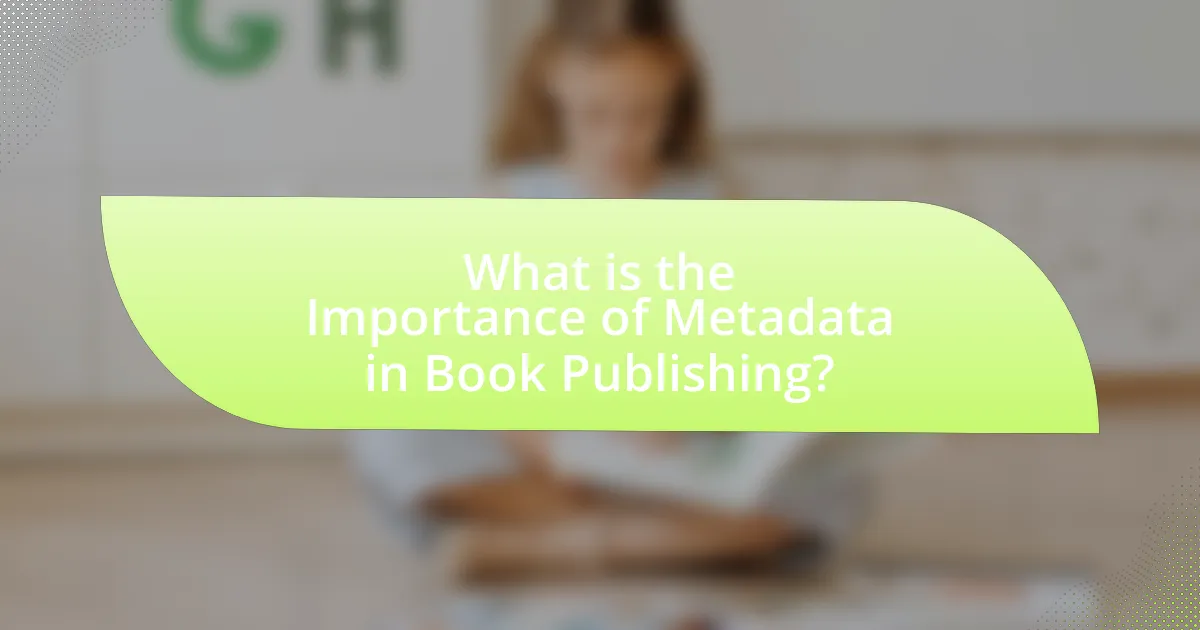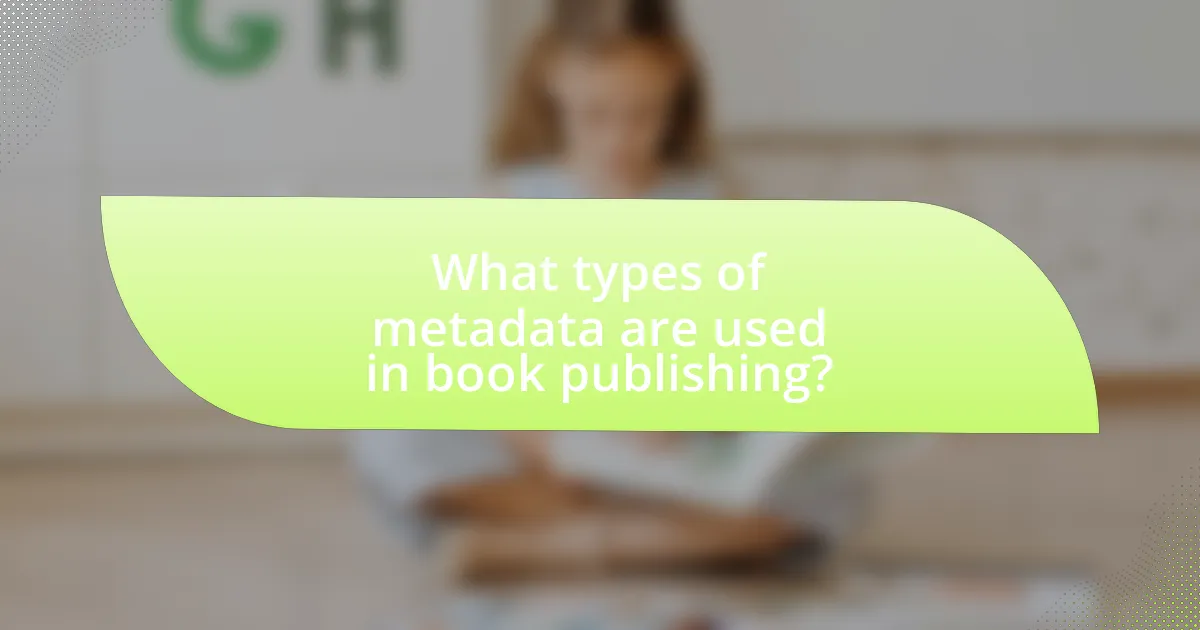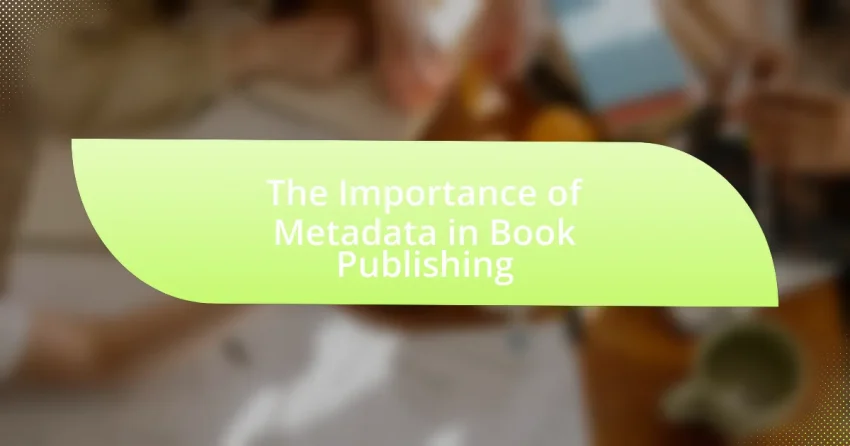Metadata is a critical component in book publishing, significantly impacting the discoverability, categorization, and sales of books. It encompasses essential information such as title, author, genre, and keywords, which enhance visibility in search results and online catalogs. Effective metadata can increase sales by up to 30% and plays a vital role in inventory management, rights management, and targeted marketing strategies. The article explores the various types of metadata, the challenges publishers face in managing it, and best practices for optimizing metadata to improve market reach and reader engagement. Additionally, it discusses emerging trends and the influence of technology, including artificial intelligence, on metadata usage in the publishing industry.

What is the Importance of Metadata in Book Publishing?
Metadata is crucial in book publishing as it enhances discoverability and categorization of books. It provides essential information such as title, author, genre, and keywords, which help readers and retailers find relevant titles. According to the Book Industry Study Group, effective metadata can increase sales by up to 30% by ensuring that books appear in search results and are accurately represented in online catalogs. Furthermore, metadata facilitates inventory management and sales tracking, allowing publishers to analyze market trends and reader preferences effectively.
How does metadata influence the discoverability of books?
Metadata significantly influences the discoverability of books by providing essential information that helps readers find relevant titles. This information includes details such as the book’s title, author, genre, keywords, and descriptions, which are crucial for search engine optimization and cataloging in libraries and online platforms. For instance, a study by the Book Industry Study Group found that 70% of readers discover books through online searches, highlighting the importance of accurate and comprehensive metadata in enhancing visibility. Properly structured metadata ensures that books appear in search results when potential readers use specific terms, thereby increasing the likelihood of sales and readership.
What are the key elements of metadata that enhance searchability?
The key elements of metadata that enhance searchability include title, author, keywords, description, and genre. Title and author are fundamental as they directly relate to user queries; a well-chosen title can significantly improve discoverability. Keywords serve as critical search terms that align with potential readers’ interests, while a concise and informative description provides context and entices users. Genre categorization helps in targeting specific audiences, making it easier for readers to find relevant content. According to a study by the Book Industry Study Group, effective metadata can increase discoverability by up to 30%, demonstrating the importance of these elements in enhancing searchability.
How do different metadata formats impact visibility in online platforms?
Different metadata formats significantly impact visibility in online platforms by influencing how content is indexed and discovered. For instance, structured metadata formats like Schema.org enhance search engine optimization (SEO) by providing clear, standardized information that search engines can easily interpret, leading to higher rankings in search results. Conversely, unstructured or poorly formatted metadata can hinder visibility, as search engines may struggle to categorize and display the content effectively. Research indicates that books with well-structured metadata are 30% more likely to be discovered by readers on platforms like Amazon and Google Books, demonstrating the critical role of metadata formats in enhancing online visibility.
Why is metadata crucial for sales and marketing strategies?
Metadata is crucial for sales and marketing strategies because it enhances discoverability and targeting of products. In the context of book publishing, effective metadata includes details such as title, author, genre, and keywords, which help potential readers find books through search engines and online retailers. According to a study by Bowker, 70% of book sales occur online, making accurate metadata essential for visibility in a crowded marketplace. Furthermore, well-structured metadata allows publishers to analyze market trends and consumer behavior, enabling more effective marketing campaigns tailored to specific audiences.
How does accurate metadata affect sales performance?
Accurate metadata significantly enhances sales performance by improving discoverability and targeting of products. When metadata is precise, it allows potential customers to find books more easily through search engines and online retailers, leading to increased visibility. For instance, a study by Bowker indicated that 70% of book buyers discover titles through online searches, underscoring the importance of well-structured metadata in driving sales. Furthermore, accurate metadata ensures that books are categorized correctly, which helps in reaching the right audience, ultimately resulting in higher conversion rates and sales figures.
What role does metadata play in targeted marketing campaigns?
Metadata plays a crucial role in targeted marketing campaigns by providing essential information that helps identify and reach specific audience segments. This information includes details such as genre, keywords, author information, and publication date, which enable marketers to tailor their strategies effectively. For instance, a study by the Book Industry Study Group found that books with optimized metadata are 30% more likely to be discovered by potential readers, demonstrating the direct impact of well-structured metadata on marketing success. By leveraging metadata, publishers can enhance visibility, improve searchability, and ultimately drive sales in a competitive market.

What types of metadata are used in book publishing?
In book publishing, the primary types of metadata include bibliographic metadata, descriptive metadata, structural metadata, administrative metadata, and rights metadata. Bibliographic metadata encompasses essential details such as the title, author, ISBN, and publication date, which are crucial for cataloging and discovery. Descriptive metadata provides additional information about the content, including genre, keywords, and summaries, aiding in marketing and searchability. Structural metadata outlines the organization of the book, detailing chapters and sections, which enhances navigation. Administrative metadata includes information related to the management of the book, such as file formats and preservation details. Rights metadata specifies copyright information and licensing terms, ensuring legal compliance and proper usage. Each type of metadata plays a vital role in the discoverability, management, and distribution of books in the publishing industry.
What are the main categories of metadata in the publishing industry?
The main categories of metadata in the publishing industry are descriptive metadata, administrative metadata, and structural metadata. Descriptive metadata includes information that helps identify and describe the content, such as title, author, and keywords. Administrative metadata provides details about the management of the content, including copyright information and publication dates. Structural metadata outlines the organization of the content, such as chapters and sections. These categories are essential for effective cataloging, discovery, and management of published works, facilitating easier access and retrieval for readers and libraries.
How do bibliographic metadata and descriptive metadata differ?
Bibliographic metadata and descriptive metadata differ primarily in their focus and purpose. Bibliographic metadata provides essential information about a publication, such as the title, author, publisher, publication date, and ISBN, which facilitates the identification and retrieval of the work within library catalogs and databases. In contrast, descriptive metadata offers detailed information about the content and context of the publication, including summaries, keywords, and subject classifications, which enhance discoverability and understanding of the material. This distinction is crucial in book publishing, as bibliographic metadata ensures proper cataloging, while descriptive metadata enriches user engagement and accessibility.
What is the significance of technical metadata in e-books?
Technical metadata in e-books is significant because it provides essential information about the digital file’s structure, format, and encoding, which ensures proper rendering and accessibility across various devices and platforms. This metadata includes details such as file type, encoding standards, and the presence of embedded fonts or images, which are crucial for maintaining the integrity of the e-book’s content. For instance, the EPUB format, widely used for e-books, relies on technical metadata to facilitate compatibility with e-readers and software, ensuring that users have a consistent reading experience. Furthermore, accurate technical metadata aids in the discoverability of e-books in digital libraries and marketplaces, as it allows for better indexing and searchability, ultimately enhancing the visibility of the content to potential readers.
How does metadata support rights management and copyright issues?
Metadata supports rights management and copyright issues by providing essential information about ownership, licensing, and usage rights associated with a work. This structured data enables publishers and creators to clearly define and communicate the legal rights tied to their content, facilitating proper attribution and preventing unauthorized use. For instance, the inclusion of International Standard Book Numbers (ISBNs) and Digital Object Identifiers (DOIs) in metadata helps track and manage rights across various platforms, ensuring that creators receive appropriate royalties and credit. Furthermore, metadata can include specific licensing terms, such as Creative Commons licenses, which explicitly outline how a work can be used, thereby reducing the risk of copyright infringement.
What information is essential for managing copyright through metadata?
Essential information for managing copyright through metadata includes the title of the work, the author’s name, the copyright holder’s name, the publication date, and the copyright notice. This metadata ensures proper attribution and legal protection of the work. For instance, the copyright notice typically includes the symbol ©, the year of first publication, and the name of the copyright owner, which collectively serve as a public declaration of ownership and rights. Accurate metadata facilitates the identification of rights holders and aids in the enforcement of copyright laws, thereby preventing unauthorized use and infringement.
How can metadata help in tracking licensing agreements?
Metadata can significantly aid in tracking licensing agreements by providing structured information about the rights associated with a work. This structured data includes details such as the license type, expiration dates, and territorial rights, which are essential for managing and enforcing agreements. For instance, the International Standard Book Number (ISBN) system incorporates metadata that specifies licensing terms, enabling publishers and authors to monitor usage and compliance effectively. Additionally, metadata can facilitate automated tracking through digital rights management systems, ensuring that all parties adhere to the terms of the licensing agreements.

What challenges do publishers face with metadata management?
Publishers face several challenges with metadata management, including data consistency, accuracy, and integration across multiple platforms. Inconsistent metadata can lead to difficulties in cataloging and discovering titles, which negatively impacts sales and visibility. Additionally, maintaining accurate metadata is crucial for effective marketing and distribution; errors can result in misrepresentation of a book’s content or genre. Integration challenges arise when publishers use various systems for different functions, making it hard to ensure that all platforms reflect the same, up-to-date information. These issues highlight the need for robust metadata management strategies to enhance operational efficiency and improve market reach.
What common pitfalls occur in metadata creation and maintenance?
Common pitfalls in metadata creation and maintenance include inconsistency, lack of standardization, and insufficient training for staff. Inconsistency arises when different team members use varying formats or terminologies, leading to confusion and errors in data retrieval. Lack of standardization can result in metadata that does not comply with industry norms, making it difficult for systems to interpret the data correctly. Insufficient training for staff can lead to misunderstandings about the importance of accurate metadata, resulting in incomplete or incorrect entries. These pitfalls can significantly hinder the discoverability and usability of published works, as evidenced by studies showing that poorly managed metadata can reduce search visibility by up to 50%.
How can inconsistent metadata affect a book’s performance?
Inconsistent metadata can significantly hinder a book’s performance by affecting its discoverability and sales. When metadata such as title, author name, genre, and keywords are inaccurate or inconsistent across platforms, it leads to confusion among potential readers and can result in lower search rankings on retail sites. For instance, a study by the Book Industry Study Group found that 70% of consumers rely on accurate metadata to find books, indicating that discrepancies can directly impact purchasing decisions. Furthermore, inconsistent metadata can lead to misclassification, making it difficult for the book to reach its target audience, ultimately reducing visibility and sales potential.
What are the consequences of outdated metadata in publishing?
Outdated metadata in publishing leads to decreased discoverability and accessibility of books. When metadata is not updated, it can result in incorrect categorization, making it difficult for readers to find relevant titles. For instance, a study by the Book Industry Study Group found that 70% of consumers rely on metadata to discover new books, indicating that outdated information can significantly hinder sales and readership. Additionally, outdated metadata can cause issues with rights management and licensing, potentially leading to legal complications. Therefore, maintaining current and accurate metadata is crucial for maximizing a book’s market potential and ensuring compliance with industry standards.
How can publishers improve their metadata practices?
Publishers can improve their metadata practices by implementing standardized metadata frameworks and regularly updating their data to ensure accuracy and completeness. Utilizing established standards such as ONIX for Books allows publishers to create consistent and comprehensive metadata that enhances discoverability across platforms. Regular audits of metadata can identify gaps or inaccuracies, which can be corrected to improve searchability. Additionally, training staff on best practices for metadata entry and management ensures that all team members understand the importance of high-quality metadata. Research indicates that books with complete and accurate metadata experience higher sales and visibility, demonstrating the direct impact of effective metadata practices on publishing success.
What best practices should be followed for effective metadata management?
Effective metadata management requires the implementation of standardized metadata schemas, regular updates, and comprehensive training for staff involved in metadata creation. Standardized schemas, such as Dublin Core or ONIX for books, ensure consistency and interoperability across platforms, facilitating better discoverability. Regular updates are crucial as they maintain the accuracy and relevance of metadata, which can directly impact sales and visibility; for instance, a study by the Book Industry Study Group found that accurate metadata can increase sales by up to 30%. Comprehensive training equips staff with the necessary skills to create and manage metadata effectively, reducing errors and improving overall quality.
How can technology assist in optimizing metadata for books?
Technology can assist in optimizing metadata for books by utilizing automated tools and algorithms that enhance data accuracy and discoverability. For instance, machine learning algorithms can analyze existing metadata to identify patterns and suggest improvements, ensuring that keywords and categories align with current market trends. Additionally, platforms like ISBN registries and bibliographic databases streamline the process of updating and maintaining metadata, allowing publishers to efficiently manage large volumes of information. Research indicates that optimized metadata can increase a book’s visibility by up to 30%, demonstrating the significant impact of technology on metadata management in the publishing industry.
What are the future trends in metadata for book publishing?
Future trends in metadata for book publishing include the increased use of artificial intelligence for metadata generation and optimization, enhanced interoperability across platforms, and a focus on richer, more granular metadata to improve discoverability. AI tools are being developed to automate the creation of metadata, ensuring consistency and accuracy, which can significantly reduce the time authors and publishers spend on this task. Additionally, as digital platforms evolve, the need for metadata that can seamlessly integrate across various systems is becoming critical, leading to the adoption of standardized formats like ONIX 3.0. Furthermore, richer metadata, including detailed content descriptions, reader demographics, and usage analytics, is being prioritized to enhance searchability and personalization in marketing strategies. These trends are supported by industry reports indicating that effective metadata management can lead to increased sales and reader engagement.
How is artificial intelligence shaping metadata usage in publishing?
Artificial intelligence is transforming metadata usage in publishing by automating the generation, categorization, and optimization of metadata. This technology enables publishers to analyze vast amounts of data quickly, ensuring that metadata is not only accurate but also tailored to enhance discoverability across digital platforms. For instance, AI algorithms can identify trends in reader preferences and adjust metadata accordingly, leading to improved sales and engagement. Additionally, AI-driven tools can streamline the tagging process, reducing manual labor and increasing efficiency in metadata management.
What emerging standards should publishers be aware of?
Publishers should be aware of the emerging standards of the International Standard Book Number (ISBN) 2020, the Digital Object Identifier (DOI) system, and the Metadata 2.0 framework. The ISBN 2020 introduces new guidelines for digital publications, enhancing the identification of e-books and audiobooks. The DOI system provides a persistent link to digital content, ensuring reliable access and citation. The Metadata 2.0 framework emphasizes richer metadata for improved discoverability and interoperability across platforms. These standards are crucial for enhancing visibility, accessibility, and the overall management of digital content in the publishing industry.
What practical tips can publishers implement for better metadata utilization?
Publishers can enhance metadata utilization by implementing structured data standards, such as ONIX for Books, which ensures consistent and comprehensive metadata across platforms. This standardization facilitates better discoverability and interoperability, as evidenced by a study from the Book Industry Study Group, which found that 80% of retailers prefer ONIX-compliant metadata for efficient inventory management. Additionally, publishers should regularly update metadata to reflect changes in pricing, availability, and content, as dynamic metadata can significantly improve sales performance. Research indicates that books with updated metadata experience a 30% increase in visibility on retail sites. Finally, leveraging analytics tools to assess metadata performance can help publishers identify gaps and optimize their strategies, leading to improved market reach and reader engagement.
